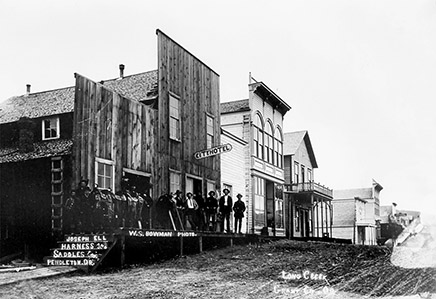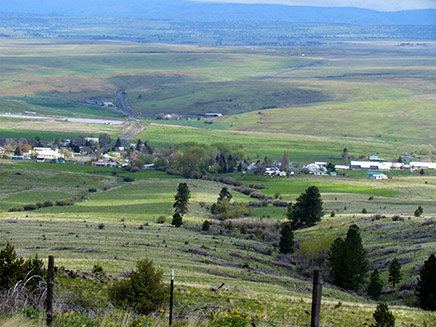CONTINUED FROM THE PRINT EDITION:
Deadly little tornado was worst in Oregon history
Writing in his July 8, 1894, edition, Long Creek Eagle editor (and town mayor) Orin Patterson described its inception: “With a roar and a rumble which was no less than the effect of a severe windstorm in the forest surrounding Fox Valley,” he writes, “two angry looking clouds met on the summit of the mountain three miles south of Long Creek and the work of destruction began in all its fury, taking its course almost due north.” Patterson would have no way of knowing that one of the two clouds he saw was warm and the other cold; but what happened next makes it pretty clear that such was the case. The combined cloud swirled together savagely, dropped a funnel cloud to the ground, and started racing down the mountain toward the town, gouging a half-mile-wide trail of destruction through the thick virgin-timber forest that would be visible as a scar on the mountainside for at least half a century afterward. In minutes it reached the town of Long Creek. “Dwellings, barns, and store buildings were lifted into the air as if but the weight of a feather, and torn to atoms, portions of which were carried for miles distant,” Patterson writes. “For a moment the air was a thickened mass of missiles, flying in every direction.” At the same time, the cloud above were releasing hail, and if someone had been able to preserve some of it, it probably would have set a national record for size. But it was also very unusual stuff, according to S.M. Blandford, the officer in charge of the U.S. Weather Bureau in Portland, who reported his correspondent told him, “The formation was more in the nature of sheets of ice than simple hailstones. The sheets of ice averaged 3 to 4 inches square and from 3/4 to 1 1/2 inches in thickness. They had a smooth surface and in falling gave the impression of a vast field or sheet of ice suspended in the atmosphere and suddenly broken into fragments about the size of the palm of the hand.” Some of the residents managed to get out of the way of the fast approaching funnel cloud, but three of the houses it hit and demolished were occupied. One of them was the home of David and Sarah Parrish — the refugee couple who’d fled Kansas to get away from tornadoes, both of whom died at the whim of this one. Another was the Nichols residence, home of Dr. and Mrs. Nichols. Both were badly injured, and their infant daughter, Blanche, was killed. The Parrishes and little Blanche were the only fatalities from the storm. Six others were injured, some very badly. One lucky stormwatcher, I.W. Splawn, was snatched up off the ground and carried high into the air over the top of a store before being dashed to the ground — but he landed in a haystack and was completely uninjured. The storm also picked up a piano, probably from Dr. Nichols’ house, and hurled it several hundred yards.
|

“Those houses that had escaped being destroyed were thrown open to the wounded and medical assistance was summoned,” Patterson writes, “while the dead bodies were taken to City Hall and prepared for interment.” “With all its fury the cyclone swept everything in its course and, of over two dozen structures destroyed, there is not enough left to erect a decent dwelling,” he adds.
As if that weren’t enough, the “Panic of 1893” (actually a full-blown depression) was in full swing. There just wasn’t much relief money available, and there were lots of other disasters competing for what there was. So Long Creek pretty much had to do its best with what it had. They managed; but after that day there wasn’t any further talk of taking over as county seat. Today, Long Creek is a nice little community well off the beaten track, and home to somewhere in the neighborhood of 200 people. The weather in the summer is about as close to perfect as it gets — the average highs in the hottest months, July and August, top out at 84 degrees — and winters are not bad either. It’s easy to see why people loved it, back in 1894, and didn’t expect that balmy, mellow weather to suddenly turn as deadly as it did.
|


